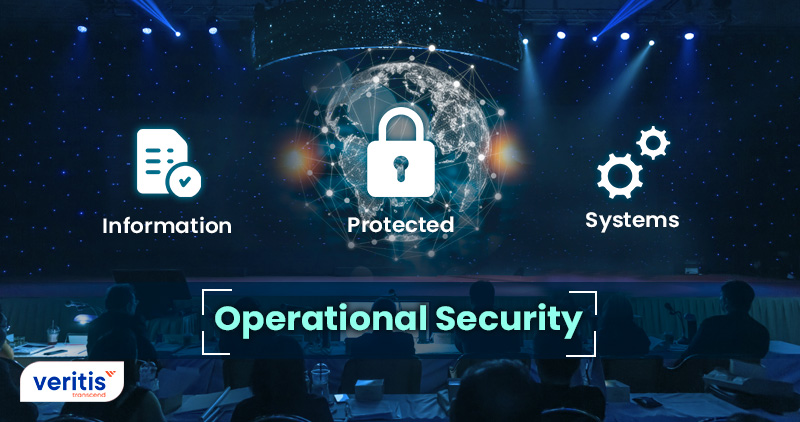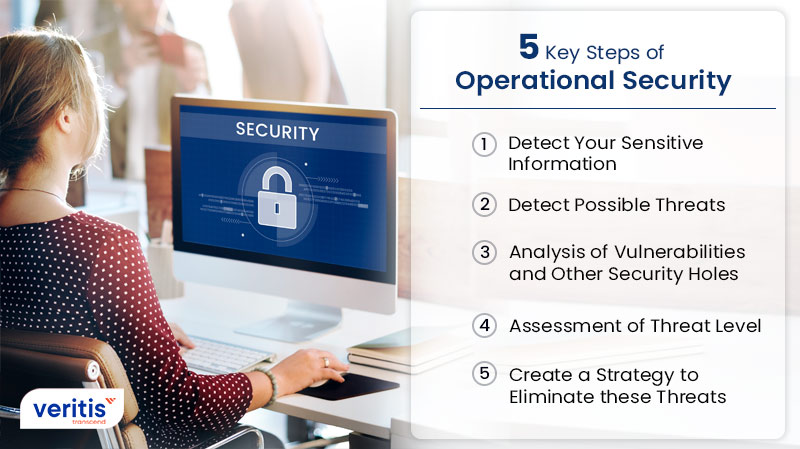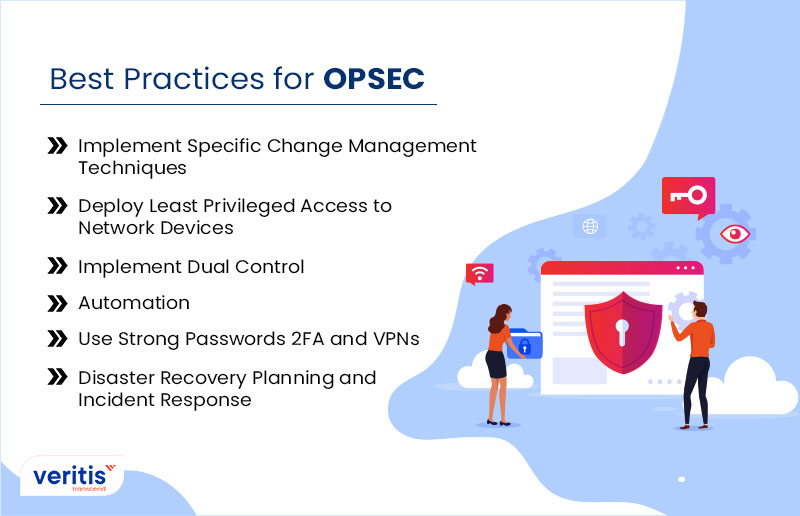
Operational security (OPSEC), also known as procedural security, was created by the US military during the Vietnam War. This application is widely used in business as a risk management plan for preventing sensitive data without malicious intent. OPSEC is a plan that challenges IT and security pros to look at their operations and systems from the view of a hacker. It includes analytical tasks and procedures such as social media, behavior monitoring, and security best practices.
OPSEC aims to close all security holes that allow threat actors to steal sensitive data from an organization. Robust security isn’t about having the proper hardware or software; it’s about knowing exactly how they work and where the gaps are. When used alone, not every type of information is regarded as sensitive. However, if a hacker combined this data, they could use it for different things, such as creating convincing phishing emails or accessing user accounts.
Raising awareness of this problem can be challenging. The OPSEC approach will produce a framework for adopting policies and best practices. Whether an organization can set guidelines for employees depends on the detected vulnerabilities and threats to its business. This blog post will explain OPSEC, its five steps, and its best practices.
Talk To Our Operational Security Expert
What is Operational Security?

OPSEC is a military term for plans to prevent potential enemies from learning important information about operations. This concept has transferred from the military to other branches of the federal government, including the Department of Defense (DOD). OPSEC plans are now used in corporate operations as information management and protection, which have become key to success in the private sector.
OPSEC is all about securing sensitive information in an organization. It employs specific governance techniques to manage risk continuously. Your enterprise uses OPSEC daily, even if you aren’t aware of it. The OPSEC process can be as easy as placing a firewall between your system and the Internet to aid in the securement of information and ensure the proper disposal of hard copies.
Before you can deploy OPSEC security, you must determine the location and type of your storage. OPSEC keeps information in two categories: tacit and explicit. In terms of a company’s productivity, both are significant liabilities. The OPSEC process helps businesses address corporate data, information security, and risk management. It is employed by a company keen to safeguard its valuable data.
Importance of Operational Security
Recognizing the importance of Operational Security (OPSEC) is crucial for organizations safeguarding their financial well-being. By implementing rigorous OPSEC measures, organizations can prevent significant monetary losses from security breaches. Strong OPSEC offers several key benefits:
- Safeguarding Against Intellectual Property Theft: Prevents competitors from gaining access to proprietary processes or technologies, preserving the market advantage and revenue generation for the original innovators.
- Mitigating Legal Expenses: Reduces the risk of lawsuits from data breaches compromising customers’ personal information. Limits potential fines for non-compliance with industry regulations such as GDPR or HIPAA.
- Prevention of Ransomware-related Costs: Protects against malware and ransomware attacks that could encrypt critical systems, demanding substantial ransoms for decryption keys.
- Minimizing Costs Associated With Business Disruption: Reduces downtime resulting from cyber-attacks, which directly translates to diminished productivity and sales.
Useful link: Securing Digital Transactions: Addressing Unique Cybersecurity Challenges in Banking IT
The 5 Key Steps of Operational Security

The five steps combined in OPSEC process allow companies to secure their data processes.
1) Detect Your Sensitive Information
The first essential step in ensuring OPSEC security is understanding businesses’ data and the sensitive information they maintain on their systems. This includes detecting user information such as client’s data, financial information, employee details, and intellectual property. Companies need to concentrate their resources on protecting this essential data.
2) Detect Possible Threats
The next stage is to identify the potential threat matrix to your business. Companies must assess the potential threats once the sensitive data has been recognized. Identifying who can pose a severe threat allows you to evaluate the risk depending on the skill set of the possible opponent.
3) Analysis of Vulnerabilities and Other Security Holes
This is a key step in the information risk management process. The business must scour any security gaps that might allow threats to be displayed. Assess the current condition of your security to detect flaws that could be exploited to access your sensitive data. This should combine software and hardware security solutions, including automated security patch updates, employee awareness and training, and best practices like 2FA and strong passwords.
4) Assessment of Threat Level
The following step is to ascertain the threat level connected to most discovered vulnerabilities. Next, the organization ranks the risks depending on the factors, including the likelihood that a given assault would occur and the impact such an attack would have on operations. The system’s low, medium, or high threat level is determined.
5) Create a Strategy to Eliminate these Threats
This data allows companies with everything necessary to create a strategy to eliminate the threats detected. The last step in OPSEC security is implementing countermeasures to eliminate threats and reduce cyber risks. These frequently involve developing policies for protecting sensitive data, upgrading hardware, and training staff members on security best practices and corporate data regulations.
Useful link: Securing the Future: AI Automation Tools in Cybersecurity
OPSEC Best Practices for

OPSEC process steps apply risk management plans to detect potential threats and vulnerabilities before they are abused and pose business issues. A company can build and implement an effective and robust security plan by following the six best practices.
1) Implement Specific Change Management Techniques
Companies must put the right change management plans in place for staff members to follow in case network modifications are performed. All modifications must be controlled and managed so companies can audit and monitor the alterations.
2) Deploy Least Privileged Access to Network Devices
Allow the least access to network devices using authentication, authorization, and accounting (AAA). Employees must have the minimum access to resources, networks, and data to operate successfully. This involves applying the least privilege principle, which ensures that every program, process, and user has the minimal privileges necessary to carry out their tasks.
3) Implement Dual Control
Organizations must verify that the teams and individuals who manage security differ from those who work on your network. This strategy protects against issues like conflicts of interest and others.
4) Automation
Regarding business security, people are often the weakest links for data. In addition, human errors can result in details, mistakes, critical processes, and forgetting things. Automation can reduce these errors.
5) Use Strong Passwords, 2FA and VPNs
Data breaches frequently result from human error. It would help if you verified that strong passwords and two-factor authentication (2FA) are used on every user account and trained employees on potential phishing threats. VPNs should be used while transferring data or working remotely to ensure the data is securely encrypted.
6) Disaster Recovery Planning and Incident Response
Solid disaster and incident response plans are key components of any security defense. Even with operational solid security measures, you still need a plan for identifying risks, dealing with them, and mitigating the potential risks.
Useful link: Cloud Security Automation: Best Practices, Strategy, and Benefits
Benefits of Operational Security (OPSEC)?
1) Protection of Sensitive Information
- OPSEC process steps help safeguard sensitive information from adversaries, preventing unauthorized access or exploitation.
- By identifying critical information, OPSEC security ensures that only approved personnel can access it, reducing the risk of leaks or breaches.
2) Improved Risk Management
- OPSEC enables organizations to identify and prioritize potential risks to their operations.
- OPSEC minimizes these risks by implementing appropriate countermeasures and enhancing overall operational resilience.
3) Preserved Reputation and Trust
- Adequate OPSEC security maintains the reputation and trust of organizations by preventing damaging disclosures.
- It ensures that sensitive information, such as proprietary data or customer details, remains secure, preserving public trust.
4) Legal and Regulatory Compliance
- OPSEC helps organizations comply with legal and regulatory requirements to protect sensitive information.
- By safeguarding classified or sensitive data, OPSEC ensures adherence to laws and regulations governing data privacy and security.
5) Competitive Advantage
- OPSEC process steps provide a competitive advantage by safeguarding proprietary information and trade secrets.
- It prevents competitors or adversaries from accessing valuable intellectual property or strategic plans.
Useful link: How SaaS Business Intelligence is Revolutionizing Data Driven Decision Making
6) Adaptability and Flexibility
- OPSEC practices can adapt to threats and operational environments, ensuring continued effectiveness.
- By remaining flexible, organizations can adjust their OPSEC measures to address emerging risks and challenges.
7) Reduced Vulnerability to Espionage
- OPSEC mitigates the risk of espionage by limiting the amount of sensitive information available to potential adversaries.
- It prevents hostile actors, including foreign intelligence agencies, from gathering intelligence that could compromise national security or corporate interests.
8) Cost Savings
- OPSEC helps avoid the financial consequences of security breaches, including legal fees, regulatory fines, and reputational damage.
- By investing in proactive security measures, organizations can reduce the potential costs related to data breaches or operational disruptions.
Rules to Use for OPSEC
Let’s explore some rules to use to secure your data online.
- Don’t share your personal information, such as IP addresses, emails, and cookies.
- Don’t risk it by visiting online areas such as the dark web, etc.
- Sending encrypted data isn’t recommended
- Don’t reveal any personal information about yourself
- Don’t believe untrustworthy websites
Final Thoughts on OPSEC
Risk management combines detecting flaws and threats before the issue arises. OPSEC compels managers to scrutinize their operations to detect any points where their information is vulnerable. IT Managers can detect flaws they might have overlooked by viewing processes from the view of a malicious third party. Then, they can implement the appropriate countermeasures to secure sensitive data.
Veritis, the Stevie Awards and Globee Business Award winner, offers a wide range of solutions that guide businesses to enhance their most sensitive data, improve their data security, and ensure the constant security of their users and devices. We have enough expertise in providing security solutions in a dynamic environment. So, contact us and work without further ado to protect your proprietary data before it’s too late.
Explore Managed Security Services Got Questions? Schedule A Call